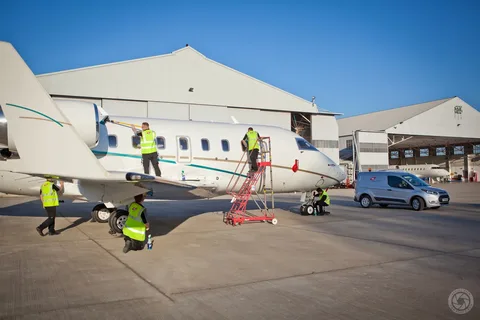Aircraft detailing is a crucial aspect of aviation maintenance that goes beyond mere cleanliness. It involves meticulous care and attention to detail to ensure that aircraft not only look great but also perform optimally. This ultimate guide will provide expert tips for aviation maintenance professionals on how to effectively detail aircraft for enhanced safety, efficiency, and aesthetics.
Aircraft detailers clean the exterior and interior of an aircraft to restore it to like-new condition. Aircraft detailing businesses work for corporate and private aircraft owners and operators.
Like any detailing job, aircraft detailing requires specialist knowledge, tools, and products to complete it to a professional standard.
While you don’t have to be certified to be an aircraft detailing professional, you should still consider specialist training. Why? Permanent damage can be done if the wrong chemicals are used to clean the plane. For example, using ammonia-based glass cleaner on the aircraft’s windows can cause them to crack, potentially requiring replacement.
As an aircraft detailer, you must follow requirements set by the Federal Aviation Administration. This includes the use of aviation-grade and -approved cleaning products and insurances required specifically for aircraft.
1. Understanding Aircraft Detailing
What is Aircraft Detailing?
Aircraft detailing refers to the thorough cleaning, polishing, and protection of aircraft surfaces, both interior and exterior, to maintain their appearance, functionality, and longevity.
Importance of Aircraft Detailing
- Enhanced Safety: Clean and well-maintained aircraft reduce the risk of malfunctions and ensure safe operations.
- Improved Efficiency: Properly detailed aircraft experience reduced drag, leading to improved fuel efficiency and performance.
- Aesthetics: A well-detailed aircraft creates a positive impression on passengers and reflects a high standard of professionalism.
2. Exterior Aircraft Detailing
Washing and Cleaning Techniques
- Use aviation-approved cleaning products and techniques to avoid damage to sensitive aircraft surfaces.
- Employ the two-bucket method to prevent cross-contamination and scratches during washing.
- Pay special attention to areas prone to dirt buildup, such as landing gear, engine nacelles, and leading edges.
Polishing and Protecting Surfaces
- Utilize high-quality aircraft polish to restore shine and protect exterior surfaces from UV damage and corrosion.
- Apply aviation-grade paint sealants or ceramic coatings for long-lasting protection against environmental elements.
Window and Glass Care
- Clean aircraft windows and glass surfaces using aviation-specific glass cleaners to ensure clarity and visibility.
- Apply a rain repellent treatment to improve water beading and visibility during rainy conditions.
3. Interior Aircraft Detailing
Cabin Cleaning and Sanitization
- Thoroughly clean and sanitize cabin surfaces, including seats, carpets, tray tables, and lavatories, using aviation-approved cleaning agents.
- Pay attention to high-touch areas to prevent the spread of germs and maintain a hygienic environment.
Leather and Upholstery Care
- Use specialized leather cleaners and conditioners to clean and protect leather seats from drying, cracking, and discoloration.
- Vacuum and spot clean fabric upholstery to remove dirt, stains, and odors effectively.
Avionics and Cockpit Detailing
- Clean and dust avionics panels, instruments, and cockpit surfaces using anti-static cleaners to prevent dust buildup and maintain readability.
- Inspect and clean air vents and ducts to ensure proper airflow and cabin comfort.
4. Maintenance Tips and Best Practices
Regular Inspection and Maintenance
- Conduct routine inspections to identify any signs of wear, damage, or corrosion on aircraft surfaces.
- Address maintenance issues promptly to prevent further damage and ensure continued airworthiness.
Use of Professional Detailing Services
- Consider outsourcing aircraft detailing to experienced and certified aviation detailing professionals for comprehensive and expert-level care.
- Collaborate with detailing professionals to develop a customized detailing schedule based on aircraft usage and environmental factors.
5. Conclusion: Elevating Aviation Maintenance Standards
Aircraft detailing is a crucial aspect of aviation maintenance that contributes to safety, efficiency, and overall customer satisfaction. By following the expert tips outlined in this ultimate guide, aviation professionals can ensure that aircraft receive the care and attention they deserve, leading to enhanced performance, longevity, and aesthetics in the aviation industry.



